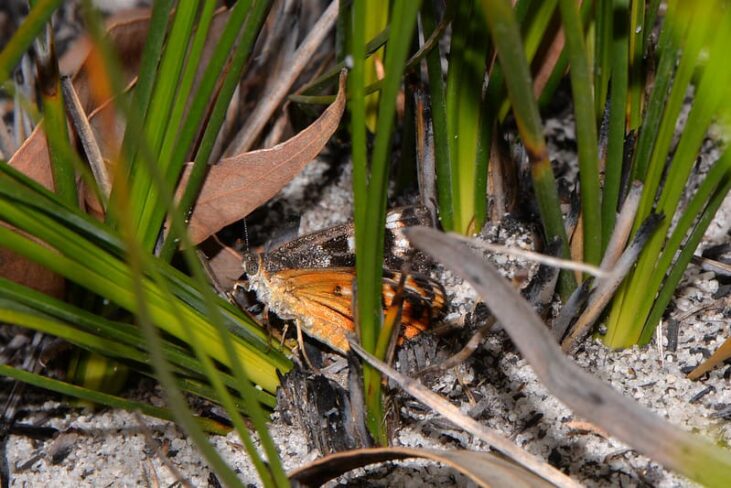In the fantastical realm of the insect world, there exists a group of enchanting beings, that commonly go by the name 'MOTH'. Derived from the Old English word "moððe," meaning "gnawing insect," moths have captivated humans for centuries with their delicate beauty and mysterious allure. While often overshadowed by butterflies, their more charismatic and colourful cousins, moths possess a unique charm that set them apart. Join us on an illuminating journey as we explore some moths of the southwest, delving into their extraordinary lives, cultural significance, ecological roles, and the challenges they face in the modern world.
What makes moths unique?
Moths, belonging to the order Lepidoptera, are insects characterized by their feathery antennae and typically nocturnal behaviour. With a history dating back over 190 million years, these resilient creatures have adapted to diverse habitats across the globe. Unlike butterflies, moths tend to possess muted colours, enabling them to blend seamlessly into their surroundings. While some species may exhibit flamboyant hues, it is their nocturnal activities that truly set them apart.
From Egg to Flight
A moth's life begins as a tiny, delicate egg laid by an adult female. After hatching, the caterpillar emerges, embarking on an insatiable feeding frenzy. As it grows, shedding its exoskeleton several times, the caterpillar stores energy for the remarkable transformation that awaits. In due time, it spins a silken cocoon, within which the miraculous metamorphosis into an adult moth takes place. With over 160,000 known species worldwide, moths display an astounding array of forms, colours, and patterns, each adapted to their unique ecological niches. Australia has around 22,000 species of moths. Only around half of these have been scientifically named. These fascinating creatures inhabit various ecosystems, from the coastal heathlands to the dense jarrah forests, playing vital roles as pollinators and indicators of ecosystem health.

Of the thousands of native moth species in the southwest region of Western Australia, we at the Centre love the Sun moths (Castniidae). They constitute a family of day-flying moths that due to their slim bodies, broad and often richly coloured wings and clubbed antennae closely resemble butterflies, but are not related. And they live amidst wetland sedges!
Cultural Significance of Moths
Moths inhabit various ecosystems, from the coastal heathlands to the dense jarrah forests, playing vital roles as pollinators and indicators of ecosystem health. Their significance in Aboriginal culture is intertwined with cultural stories and practices, many of which have been lost to time. Some recent discoveries are bringing their place in history and culture to light—historical consumption of moths has been confirmed by the discovery of an ancient grindstone. Researchers from Monash University and the Gunaikurnai people found the stone, estimated to be 2,000 years old, in Cloggs Cave, Victoria. Biochemical staining identified collagen and protein residues from Bogong moths on the stone, providing the first conclusive archaeological evidence of insect remnants on an artifact. The portable grindstone may have been used to prepare moths as cakes or pastes for smoking and preservation—moths being a native source of protein! The tradition of travelling to the cave for the Bogong season, when the moths migrate in millions, has since been lost, making this discovery a significant connection to ancestral customs and knowledge. Such stories about moths are yet to be discovered in Western Australia.
The Role of Moths in Our Ecology
Moths, often regarded as "night-time gardeners," perform invaluable services in the ecosystem. They play a pivotal role as pollinators for numerous native plants, aiding in the reproduction and survival of flora. Furthermore, moths serve as a vital food source for birds, bats, and other nocturnal predators, contributing to the delicate balance of the food web. However, the rise of biosecurity threats poses a severe challenge to their existence.
The ecological significance of moths extends far beyond their role as pollinators and prey. Moths contribute to the nutrient cycling process by aiding in decomposition as their larvae feed on decaying organic matter. They also act as indicators of environmental health, with changes in their populations reflecting alterations in habitat quality and climate patterns.
A Biosecurity Threat:
In recent years, the invasion of non-native moth species has become a growing concern. Among the common invasive species in Southwest Western Australia is the Cabbage Moth, originating from Europe. Its voracious appetite poses a significant threat to agricultural crops, requiring diligent monitoring and management. Moreover, the most dangerous invader is the Asian Gypsy Moth, capable of devastating entire forest ecosystems by defoliating trees and outcompeting native species. There is significant reseach and control systems implemented by a number of governmental and affiliated departments and organisations implementing Biosecurity measures in controlling and eradicating invasive moth species. If you are a nuturalist who dabbles in entomology, you could be of great help if you understand, encounter and report invasive moths, besides other insects that pose a threat.
The Dance of Light and Urbanization
One of the most intriguing aspects of moths is their nocturnal attraction to artificial lights. Urbanization, with its sprawling cities and bright streetlights, has disrupted the moth's delicate nocturnal ballet. Instead of navigating by the moon and stars, moths now become ensnared by artificial sources, such as street lamps and illuminated buildings. This shift has led to imbalances in moth populations, affecting their natural behaviour and interactions with other species. As cities expand, they encroach upon natural habitats, fragmenting landscapes and disrupting migratory routes. Bright artificial lights, especially at night, disorient and attract moths away from their usual behaviour patterns. This phenomenon—light pollution—can lead to decreased reproductive success and altered predator-prey dynamics, ultimately affecting entire ecosystems.
The ebbing flutter of delicate wings
The existence of moths is currently under threat. Habitat destruction, driven by urbanization, agricultural expansion, and deforestation, has resulted in the loss of critical feeding and breeding grounds for moths. Pesticide use, intended to protect crops, often harms not only pest species but also beneficial insects like moths. Climate change, with its unpredictable weather patterns and shifting temperatures, disrupts the delicate synchrony between moth life cycles and the availability of food sources.
As responsible stewards of the environment, it is our duty to ensure the survival of these guardians of the night, safeguarding their habitats and embracing sustainable living and agricultural practices. By doing so, we can protect not only moths but also the delicate interconnectedness of our world, preserving the magic they bring to our lives for generations to come.

Vert interesting and the newsletter is beautifully presented.
Such an insightful article. I loved it.